Tall growing houseplants are a stunning addition to place in any room in your home. The touch of green and the natural shapes of the foliage can help create a relaxing and elegant feel. Here you’ll find some of the most beautiful and tall houseplants that will bring your home decor to new heights.
1. Fiddle Leaf Fig (Ficus lyrata)
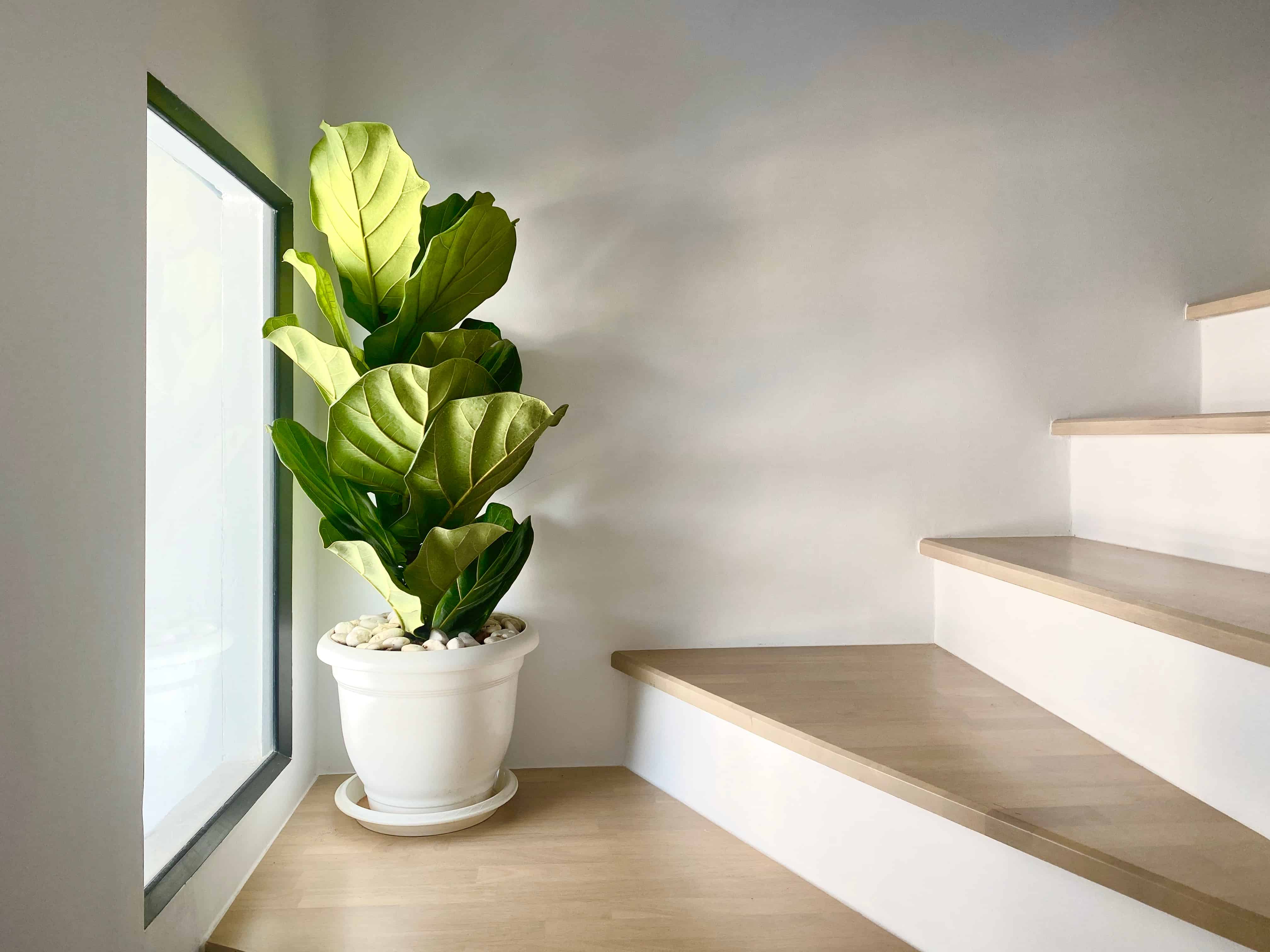
Many popular and well-loved houseplants are in the Ficus family.
©Kowit Phatipreechakul/Shutterstock.com
The fiddle leaf fig can grow up to 10 feet tall as a potted plant. The broad, fiddle-shaped leaves can also grow to be over a foot wide when they’re truly thriving! Fiddle leaf figs won’t grow as tall or have as robust leaves if they’re grown in indirect light, so be sure you’ve got a bright, sunny area that gets plenty of light throughout the day if you want this plant to reach its full potential.
2. Rubber Fig (Ficus elastica)
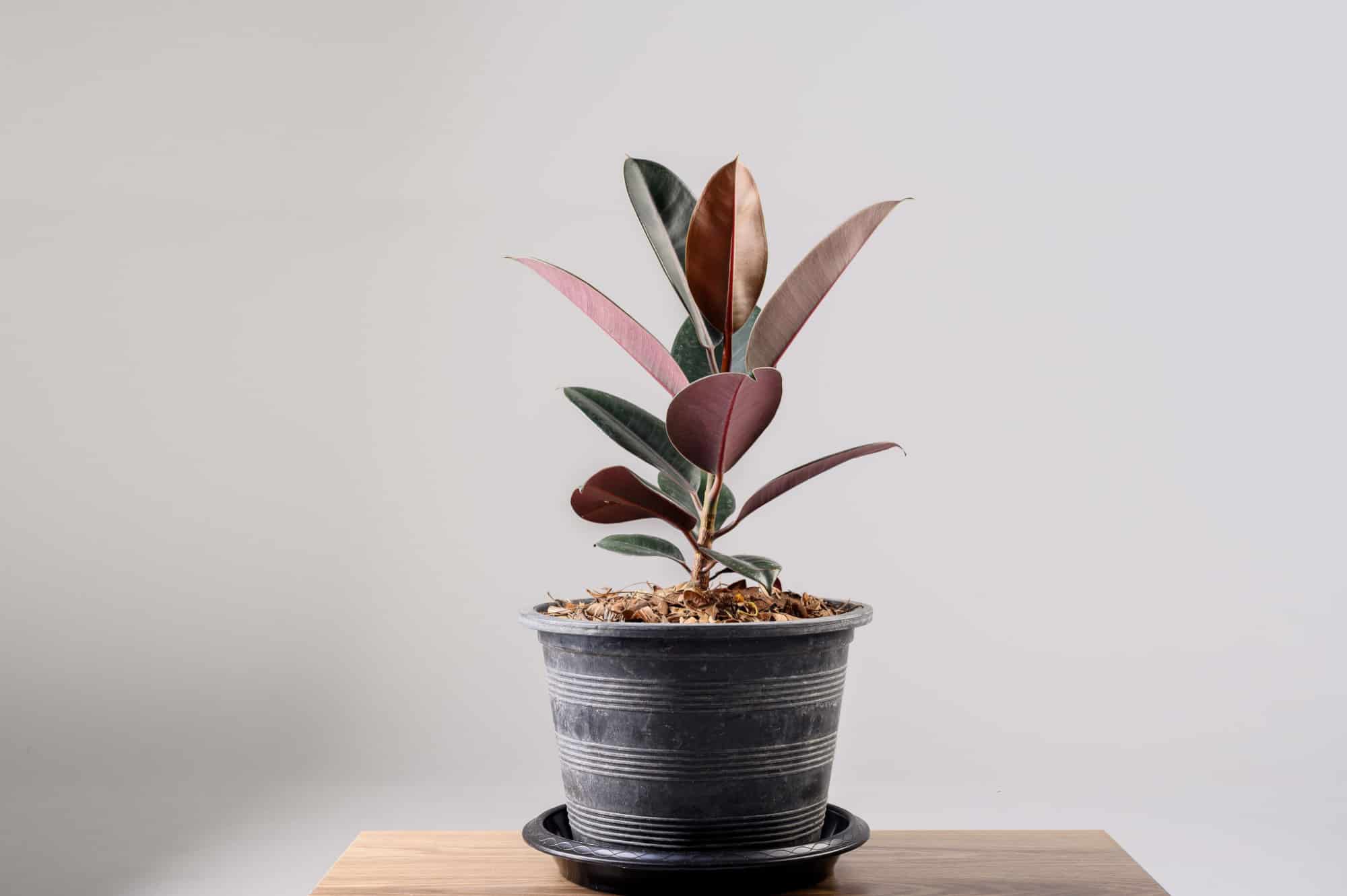
These plants are named for the latex they exude which is a natural source of rubber.
©ParkerDP/Shutterstock.com
Outdoor rubber plants can reach up to 30 feet in height, but when they’re kept as houseplants, they max out around 6-10 feet tall. The leaves are usually a deep red, almost black, color. They’re thick and when broken, you will see a white exudate called “latex”. You can also get a variegated rubber tree, which has a variety of light green, white, and green on the leaves. For whichever variety, be sure there is ample, but indirect, light.
3. Weeping Fig (Ficus benjamina)
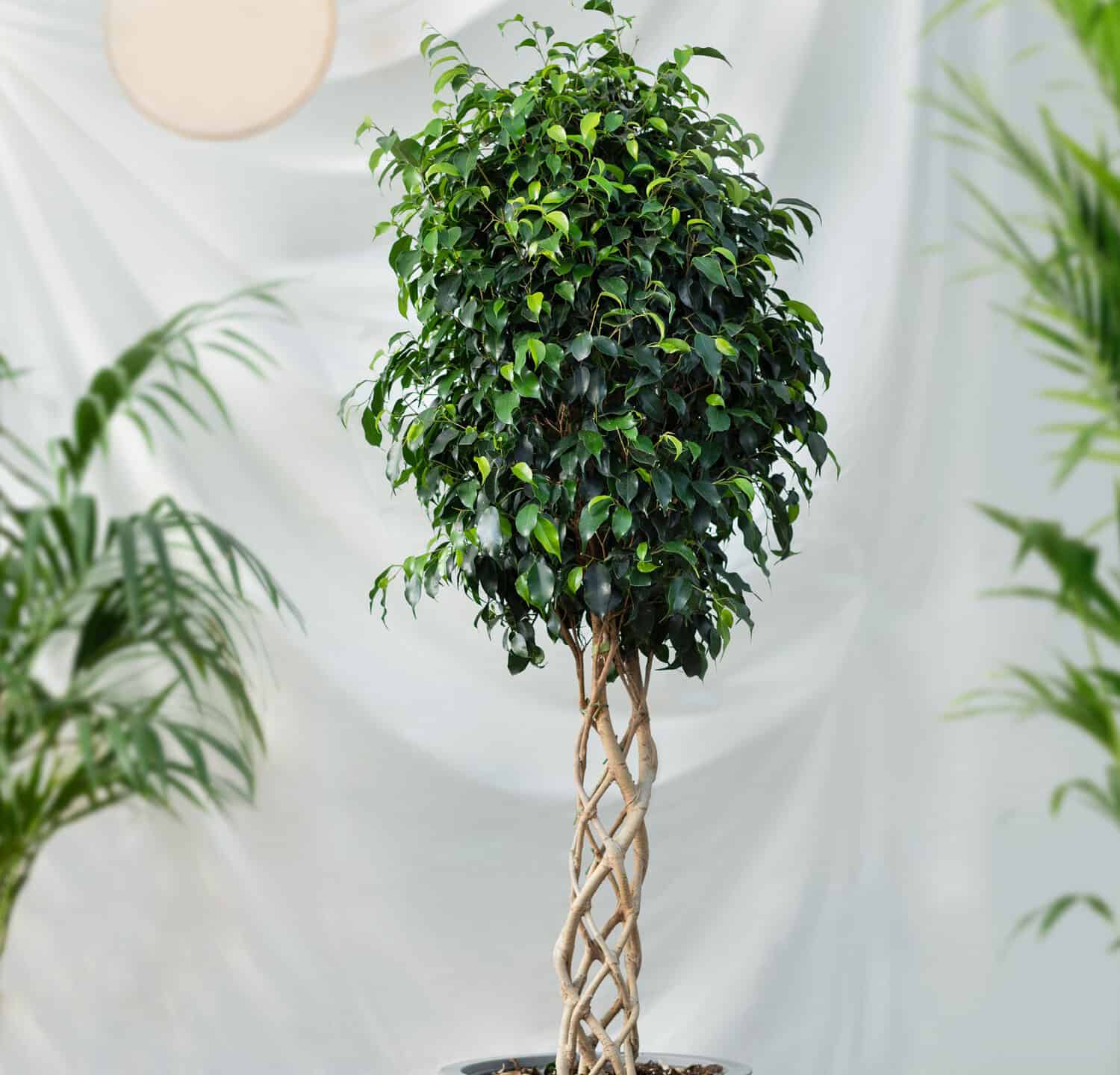
Weeping figs can be compact or sprawling, depending on how you train the stems or prune.
©Farhad Ibrahimzade/Shutterstock.com
Another popular member of the Ficus family, weeping figs is a versatile plant. They can be kept small if desired, or you can let them reach their ultimate indoor height of 10 feet when kept indoors. This species of Ficus can have their stems trained into ornamental designs, but only while they’re young and not as woody. There are also tons of different cultivars of this plant that feature different leaves and growth habits.
4. Swiss Cheese Plant (Monstera deliciosa)
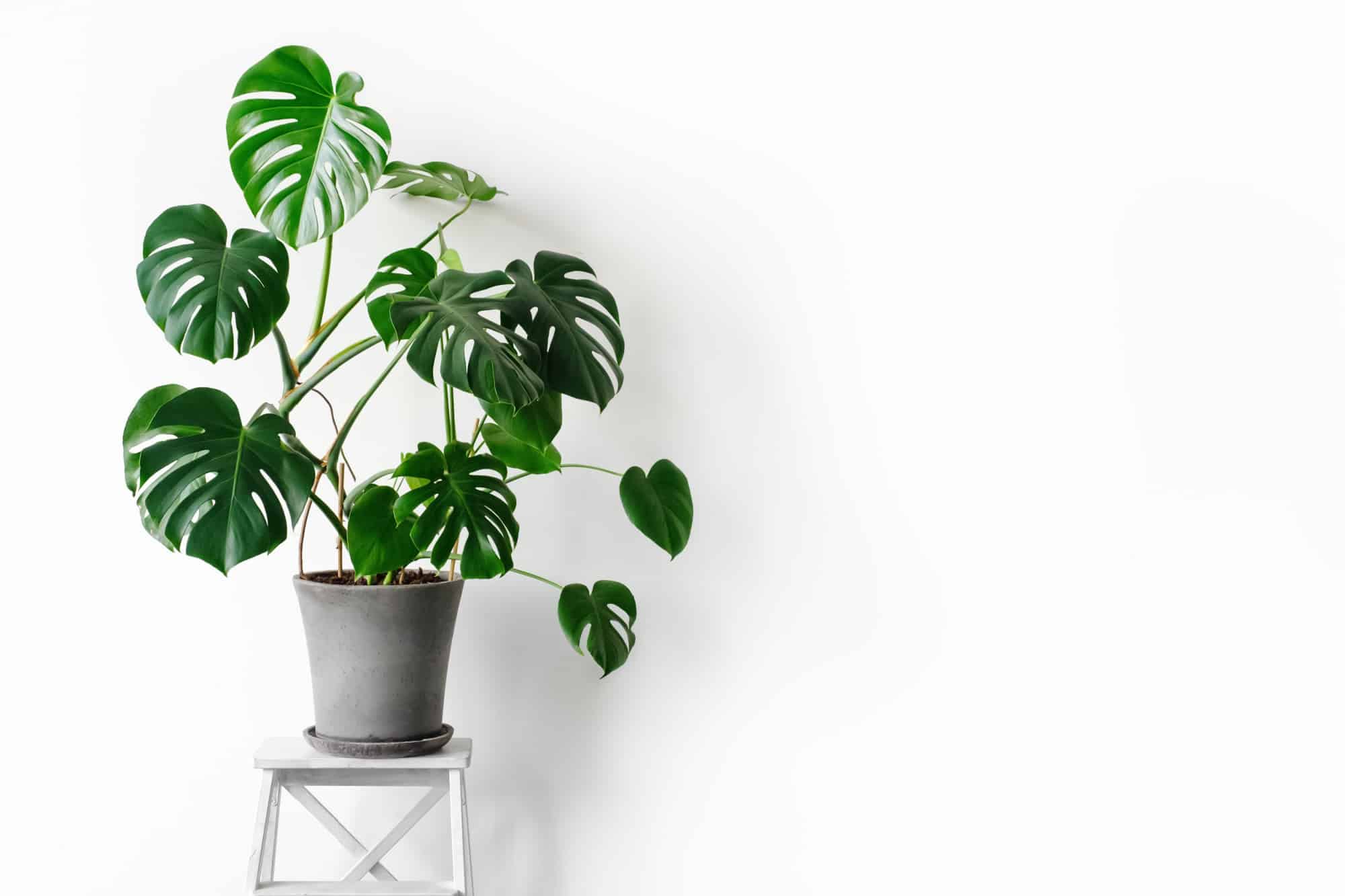
The Swiss cheese plant is a very popular tropical plant.
©Sozina Kseniia/Shutterstock.com
Also commonly called “monsteras” the Swiss cheese plant is our first climbing plant on this list. It can be trained to climb a wall, where it can entirely cover it and even continue growing on the ceiling. Alternatively, you can place a moss pole in its pot to allow it to cling and grow. This will give the illusion of a fuller, more tree-like plant. It will grow as tall and wide as you allow it to, and when it’s really happy, can easily take over any space it is allotted. Be sure to provide it with bright indirect light and plenty of humidity to simulate a rainforest habitat.
5. Dragon Tree (Dracaena marginata)
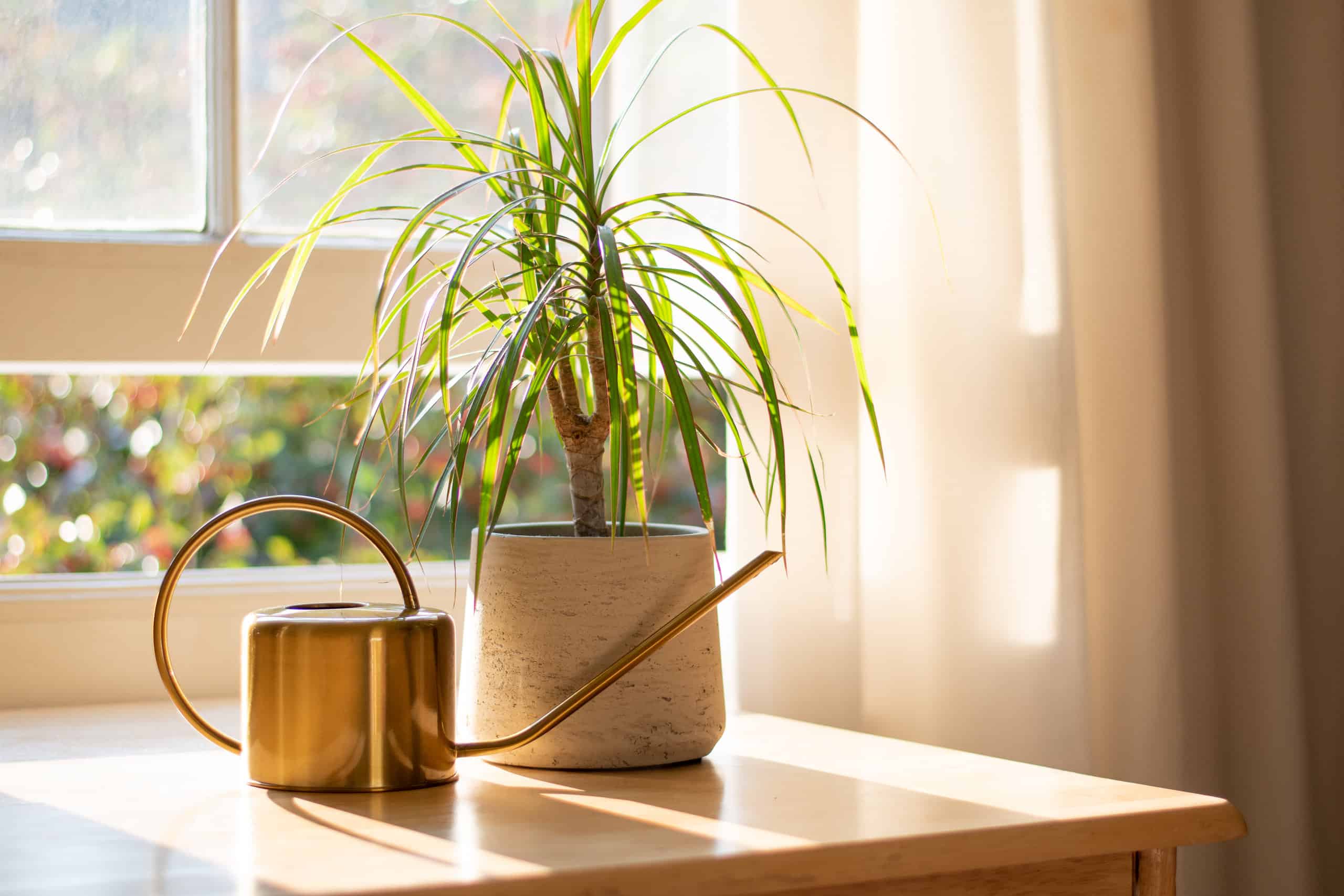
The dragon tree is a good choice for new plant owners, as it is
easy to care for
.
©Grumpy Cow Studios/Shutterstock.com
This stunning plant features long, linear leaves that come to a point at the end. Usually, the green leaves are accented with red margins. At maturity, this plant can reach 20 feet outside but can easily reach 6 feet indoors. Occasional pruning of this slow-growing plant can help you keep it in check. Dragon trees love bright light but will tolerate some shade or partial light. However, it might take longer to grow to its ultimate height if good lighting is withheld.
6. Corn Plant (Dracaena fragrans)

Some other varieties of this plant have more curly leaves or solid-colored leaves.
©Sataporn Kumsuka/ via Getty Images
This is another plant that can tolerate low light conditions without too much concern. Corn plants, named for their leaves reminiscent of corn stalks, can grow to be 4-6 feet tall. Their leaves might even grow to be half their height! These plants are tolerant of drought and don’t need much in the way of humidity. The ease of care makes adding an impressive plant to your home a breeze.
7. Ponytail Palm (Beaucarnea recurvata)
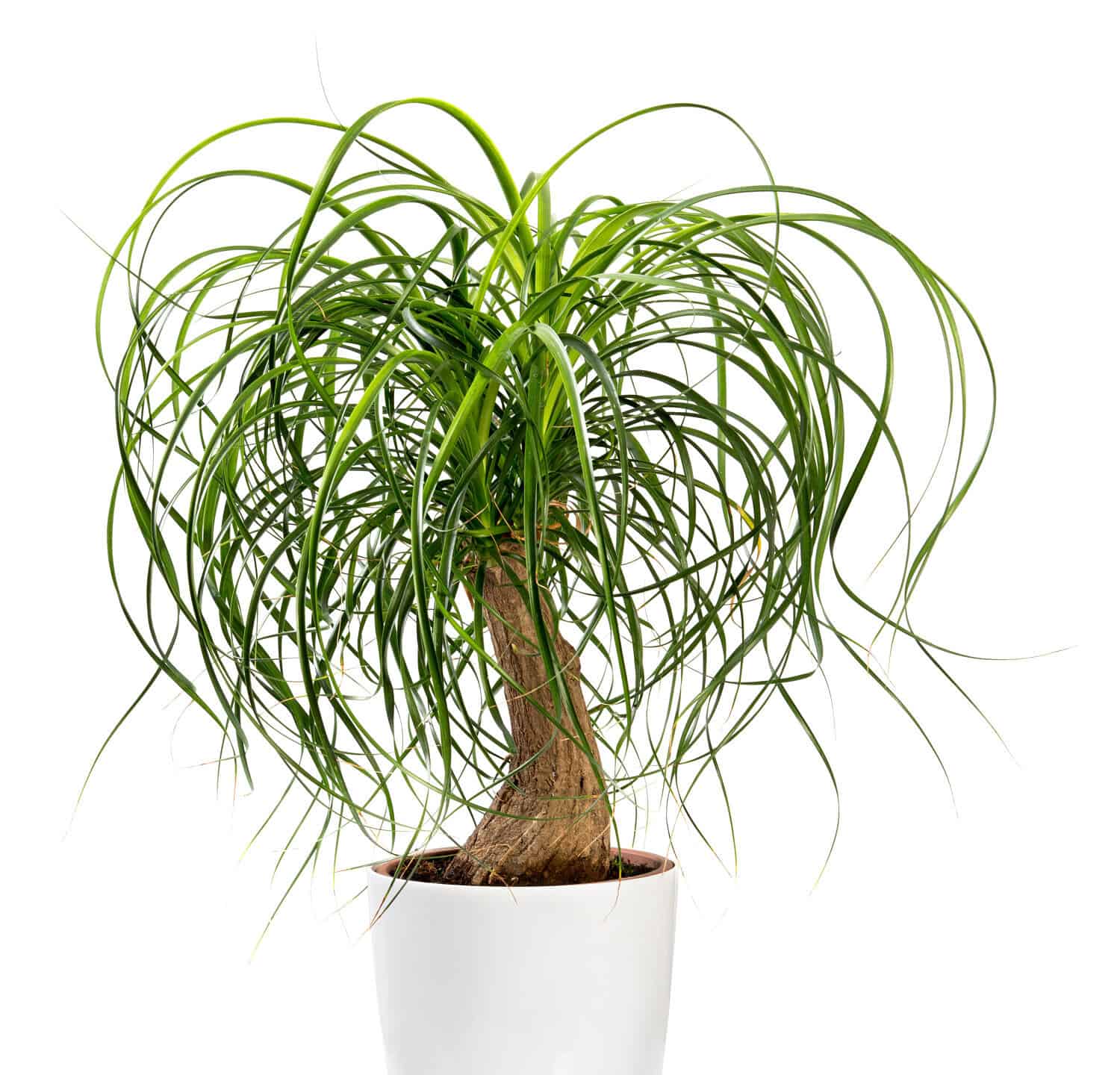
Ponytail palms are not true palms. They are members of the Agave family, which are succulents.
©Photology1971/Shutterstock.com
Indoor-grown ponytail palms can reach about 6 feet tall. Thought, it might take a long time to grow to this height. If you’re looking to immediately add a sense of “wow” with a larger plant, aim to get one that is near the size you’re looking for. Otherwise, you can expect about two inches of growth per year when kept inside. They prefer more arid conditions and can store plenty of water in their wide trunks. This method of water storage makes them pretty tolerant of forgetful plant owners.
8. Majesty Palm (Ravenea rivularis)
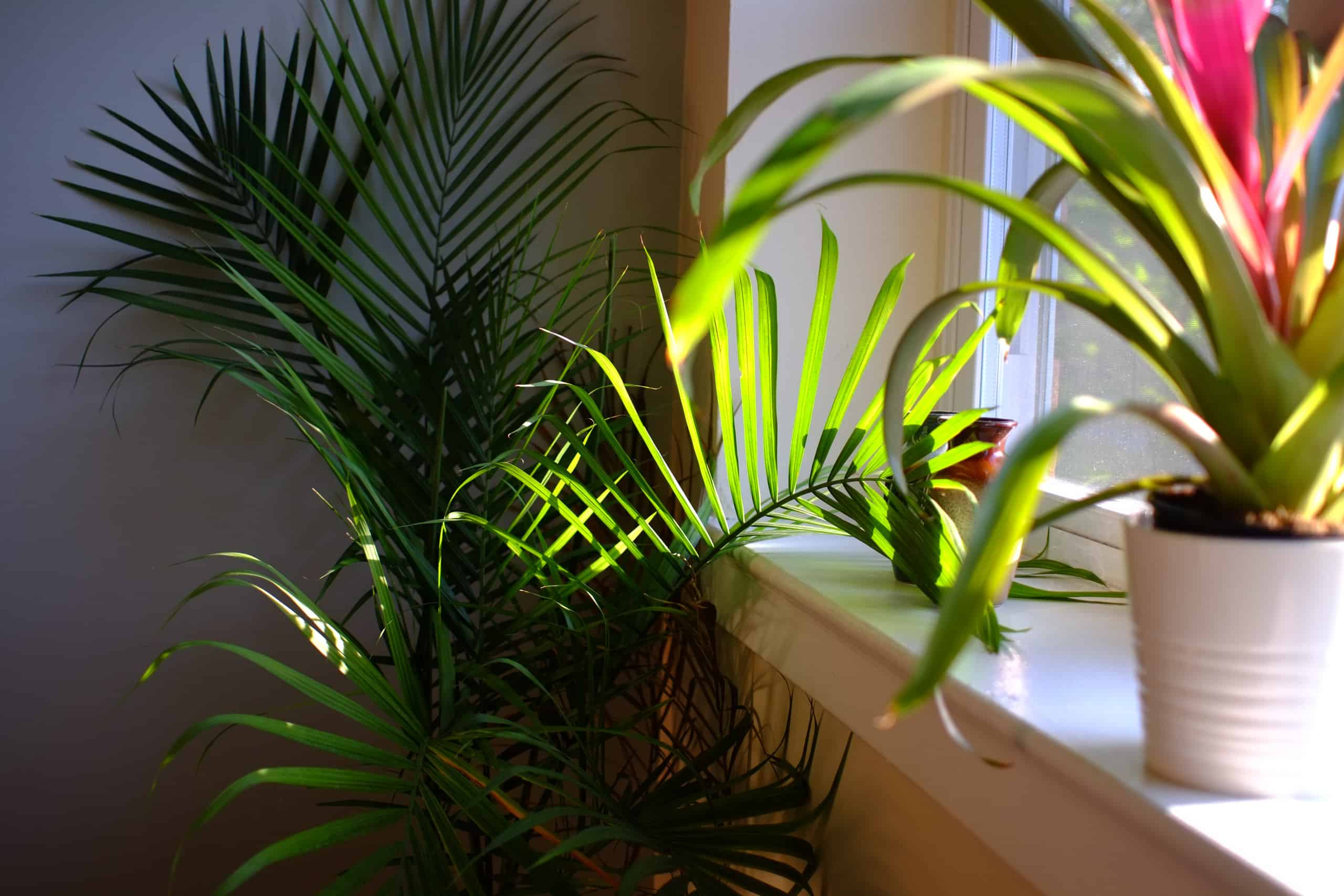
The majesty palm is a native plant of Madagascar, where it can grow over 100 feet tall.
©Pixelbender36/Shutterstock.com
Majesty palms are exactly that: majestic. Their delicate green fronds slightly curve when they grow large, giving this plant its beautiful organic shape that is prized by many of its plant owners. Inside, you can grow this plant up to 10 feet tall when given the right conditions. The key to this plant is giving it the right amount of light and fertilizer. Bright, indirect light for most of the day is its preference. Fertilize twice during the spring and summer months, diluting an all-purpose NPK fertilizer by half.
9. Parlor Palm (Chamaedorea elegans)
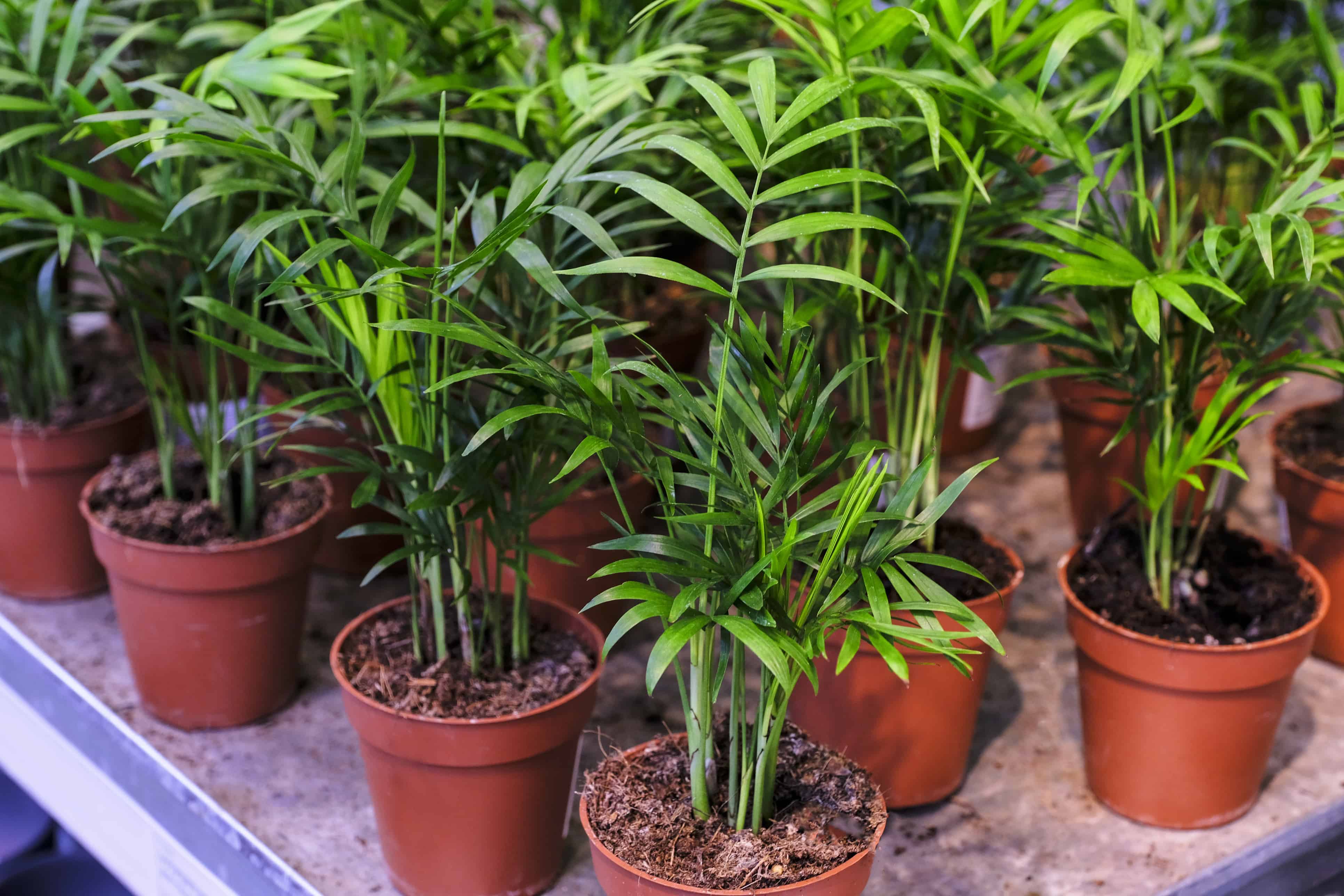
This plant is also commonly called “bamboo palm.”
©iStock.com/Olga Ostapenko
This feather-like palm can be as small as 2 feet or as tall as 7 feet when grown indoors. You can keep it small by giving it less access to light, or by keeping it in a small pot to restrict root growth. To get it as tall as you can, provide it with access to bright, indirect light (such as from an east-facing window) and fertilize it twice during the growing season.
10. Bird of Paradise (Strelitzia reginae)
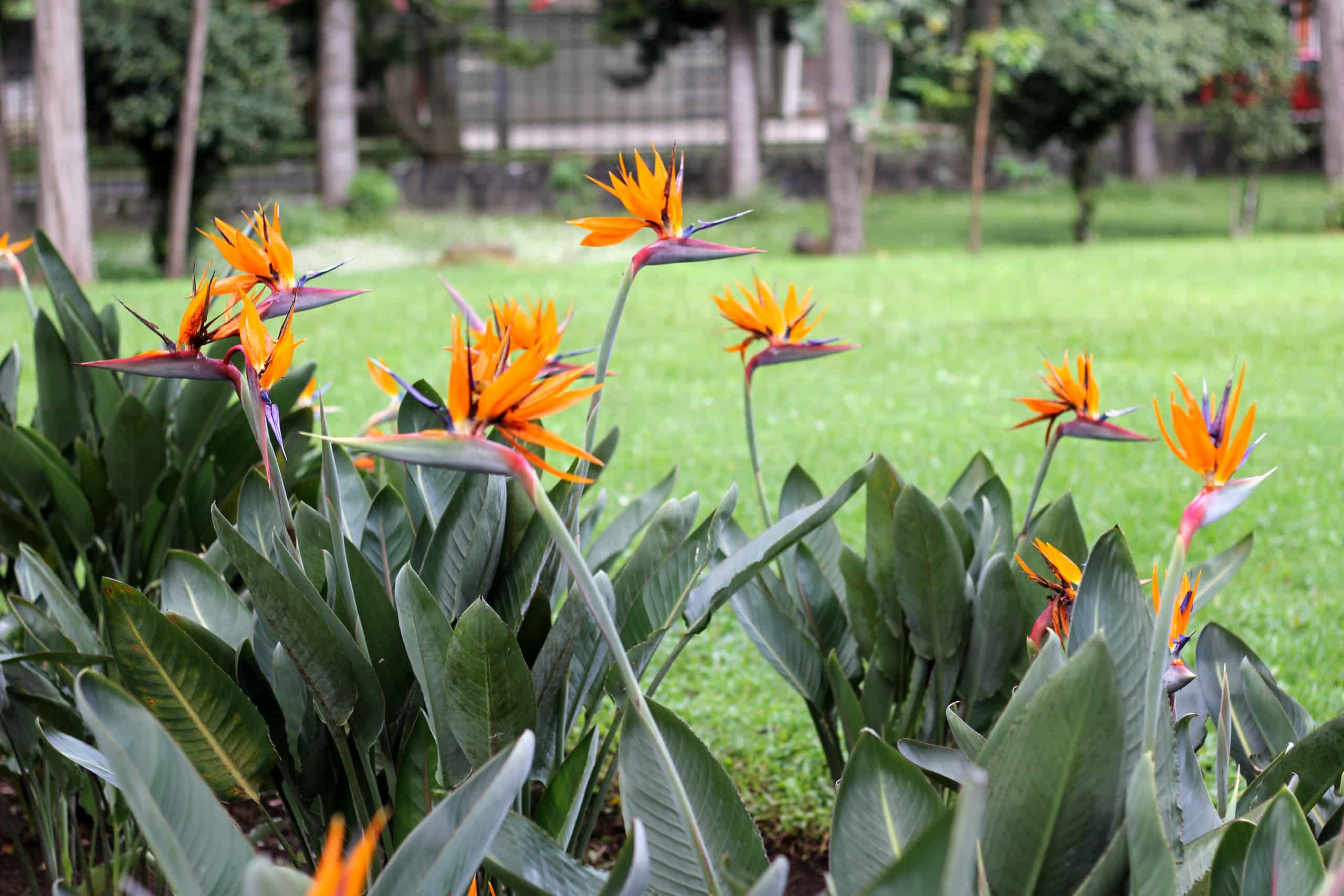
The foliage itself is impressive, but they are grown for their flowers which look like birds.
©iStock.com/Arlette Lopez
A bird of paradise plant can bloom indoors, but most who keep this plant enjoy it for its large, banana-leaf-shaped leaves. These leaves can grow to be over a foot long and often at least 6 inches wide. It’s a tall plant too, coming in at around 6 feet tall with a 5-foot-wide sprawl. The bird of paradise is a tropical-loving plant. To get it to look its best, give it at least 60% humidity, a warm room, and bright light. These conditions, combined with an all-purpose, balanced fertilizer, might also encourage it to flower.
11. Cat Palm (Chamaedorea cataractarum)

Cat palms are slow-growing palms native to tropical regions in Mexico.
©Danita Delimont/Shutterstock.com
While a cat palm isn’t the tallest growing plant, even when grown outdoors, there is something about its rounded growth habit that can give the room a serene and tropical feel. Though it only grows to be about 4-6 feet tall, the width of the plant can get up to 10 feet! Make sure you’ve got plenty of space for it. Or prune regularly to keep how wide it grows in check.
12. Norfolk Island Pine (Araucaria heterophylla)
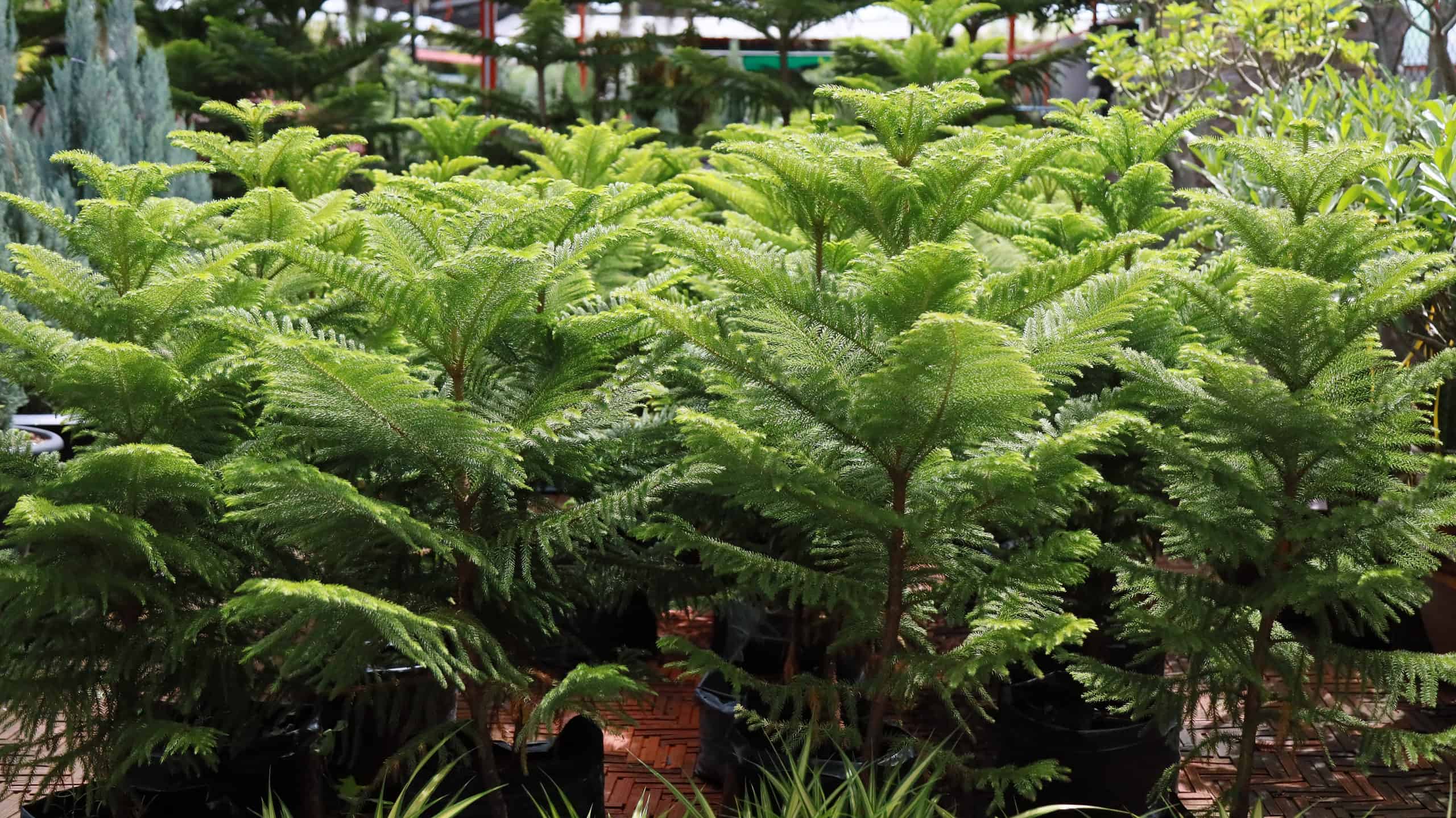
These are popular alternatives to real pine trees for the Christmas holiday.
©ZANTACUZ/Shutterstock.com
Another plant with a misnomer, these are not true pine trees. These are tropical coniferous plants with soft leaves. This plant can get between 5-8 feet tall indoors. Soft needle-like leaves grow from the branches in a triangular shape. They will stay green throughout the year. Since they’re tropical, try to keep the soil moist and humidity levels above 50% to maintain the gorgeous green hue.
13. Meyer Lemon (Citrus x meyeri)
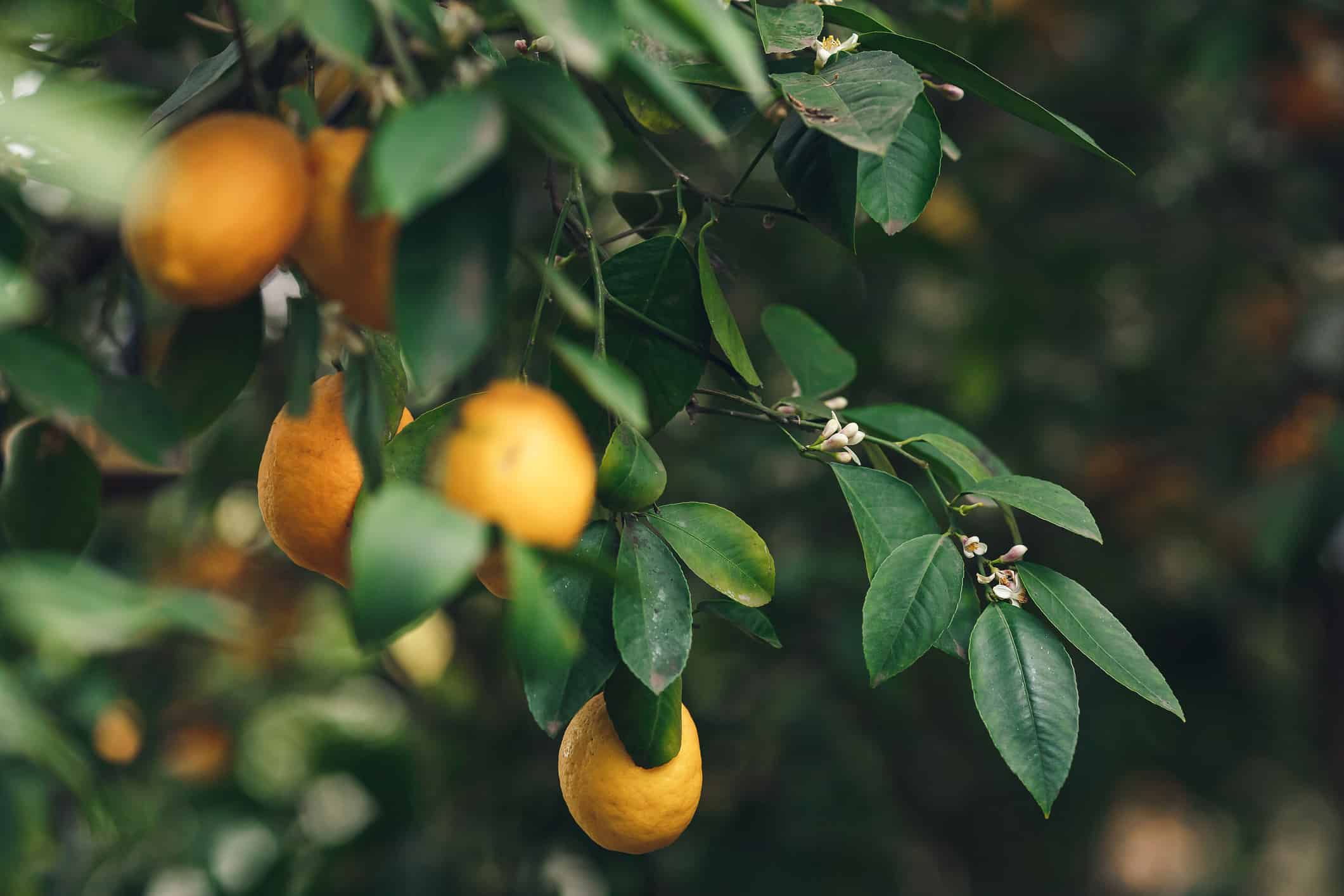
An indoor fruiting tree is not very common but can add a natural feeling to your home.
©iStock.com/MarinaVarnava
While it’s not very tall for a fruit-bearing plant, as a houseplant the Meyer lemon can get to be around 6 feet tall, or 4 feet if you’re growing a dwarf variety. Unlike other citrus varieties, it doesn’t need a colder period to fruit. That, and their glossy, deep green leaves make them favorites for a tall indoor houseplant. Plus, they have a sweeter taste than most lemons, making them perfect for desserts!
14. Creeping Fig (Ficus pumila)
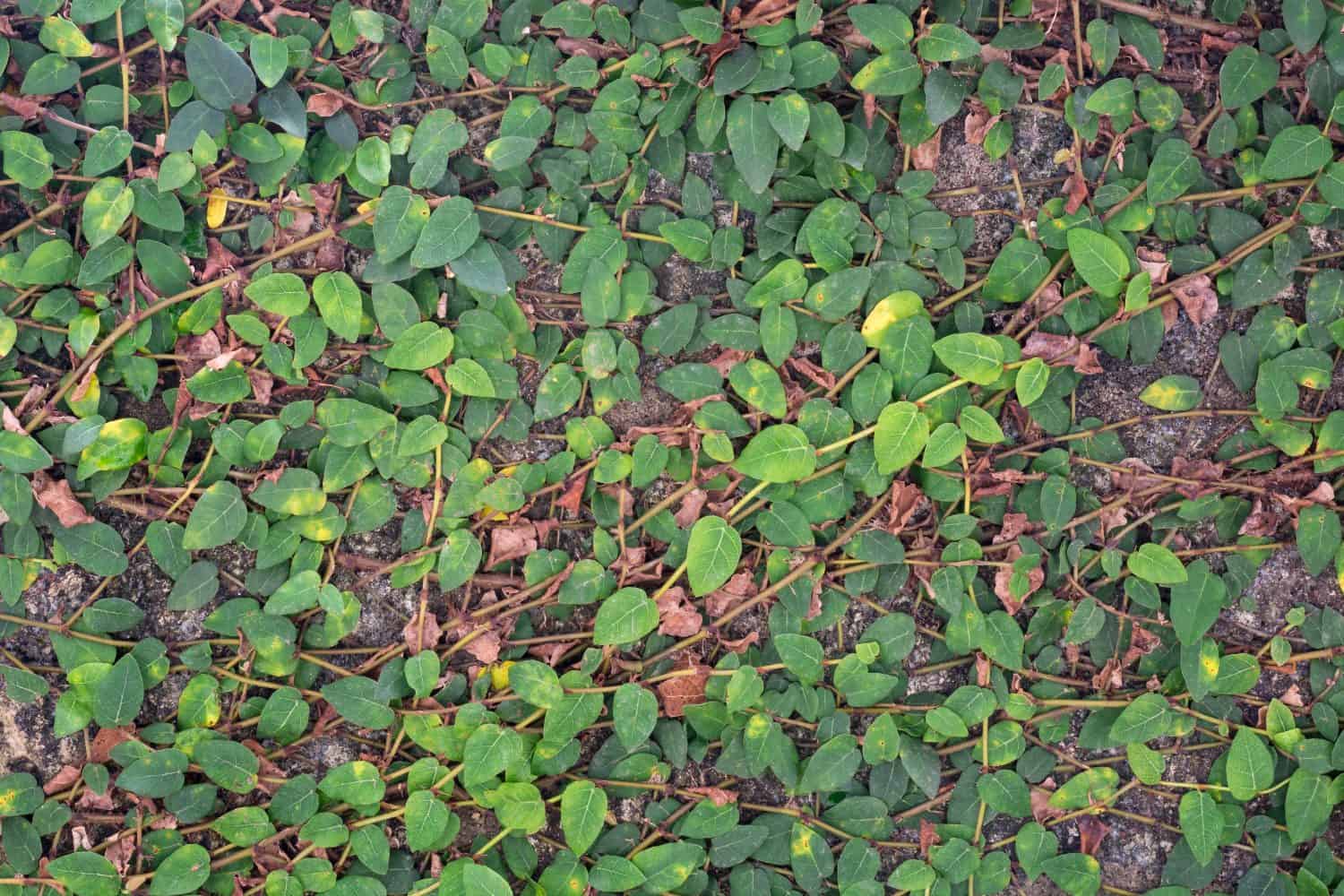
Creeping figs creepy along walls or other moist surfaces.
©Shamils/Shutterstock.com
Contrary to the name “pumila” which means “small” you can expect this houseplant to grow to be around 8 feet tall indoors. It grows well in high humidity and if you give it a surface to climb, climb it will! Creeping figs can also be grown in hanging containers and allowed to spill out of their basket. This can give your space an alternative look that differs from most plants that have a main trunk or stem.
15. Ti Plant (Cordyline fruticosa)
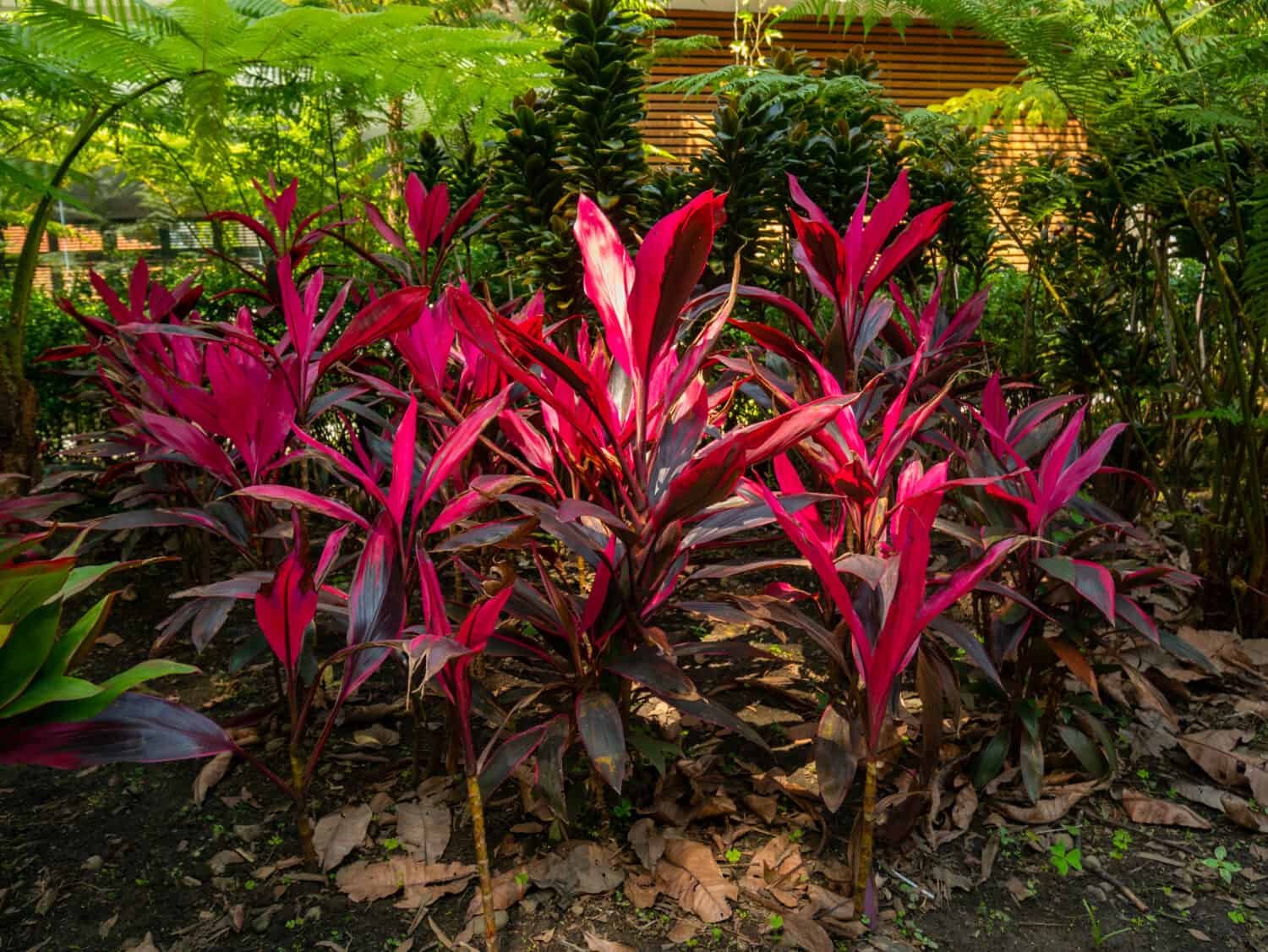
These are great for indoor or outdoor growing in tropical areas.
©Alexandre Laprise/Shutterstock.com
The bright pink and deep red color of the Ti plant makes it one of the more captivating plants on this list. It can reach around 4 feet tall when grown inside. They prefer constant temperatures above 60°F and bright, indirect light. Water such that the soil can stay moist without being soggy, as they are prone to root rot.
16. Money Tree
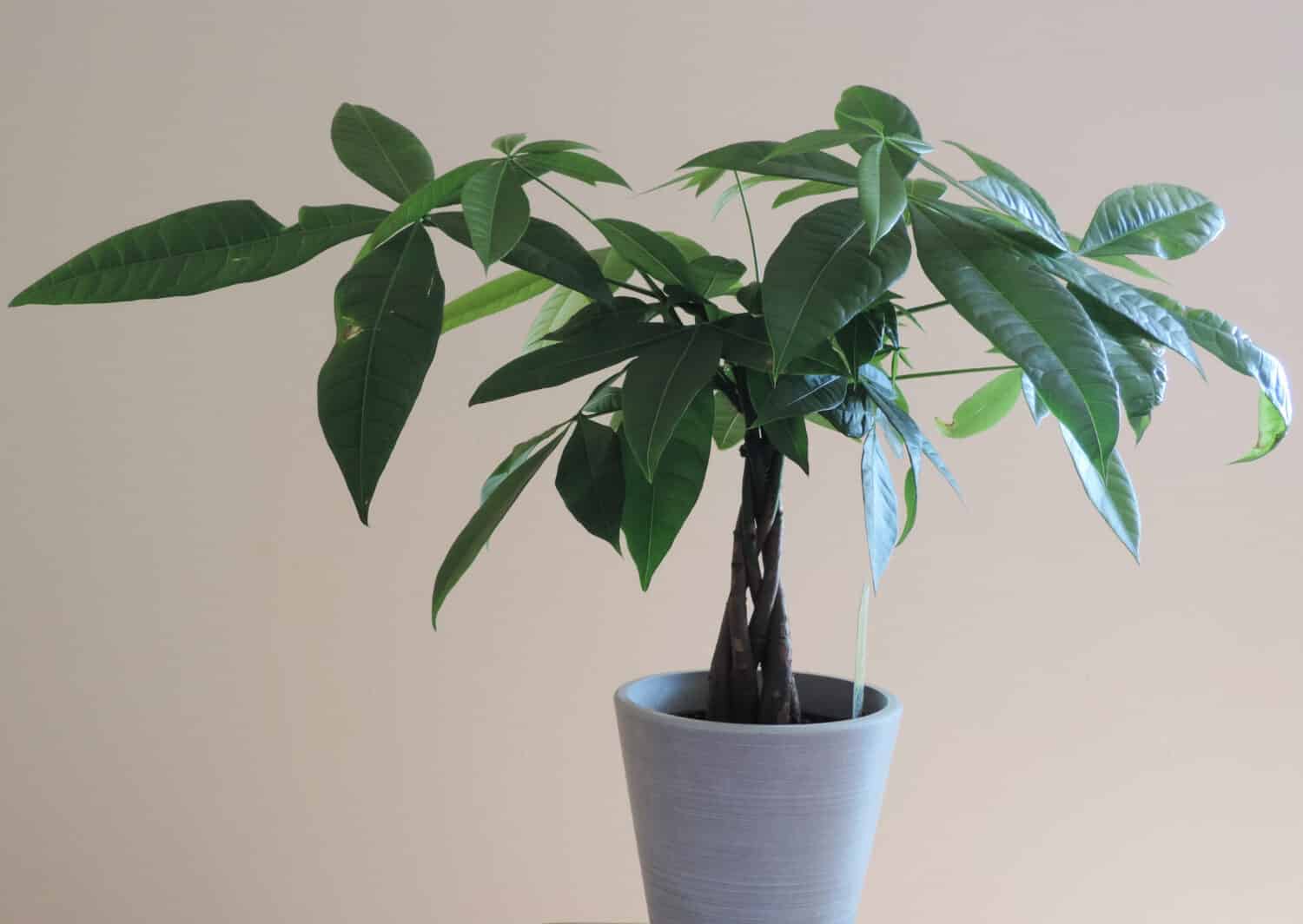
Mist your money tree often to promote healthy and lush foliage growth.
©Negin Minaei/Shutterstock.com
Money trees are another starter-friendly plant that can spur a plant addiction. Their soft and delicate leaves hailing from a dainty stem are enough to catch anyone’s eye, not to mention their trunk is often woven to provide some additional ornamentation. Money trees often will grow to be 8 feet tall. However, you can also take it to the other end of the spectrum and grow it as a bonsai.
17. Olive Tree (Olea europaea)
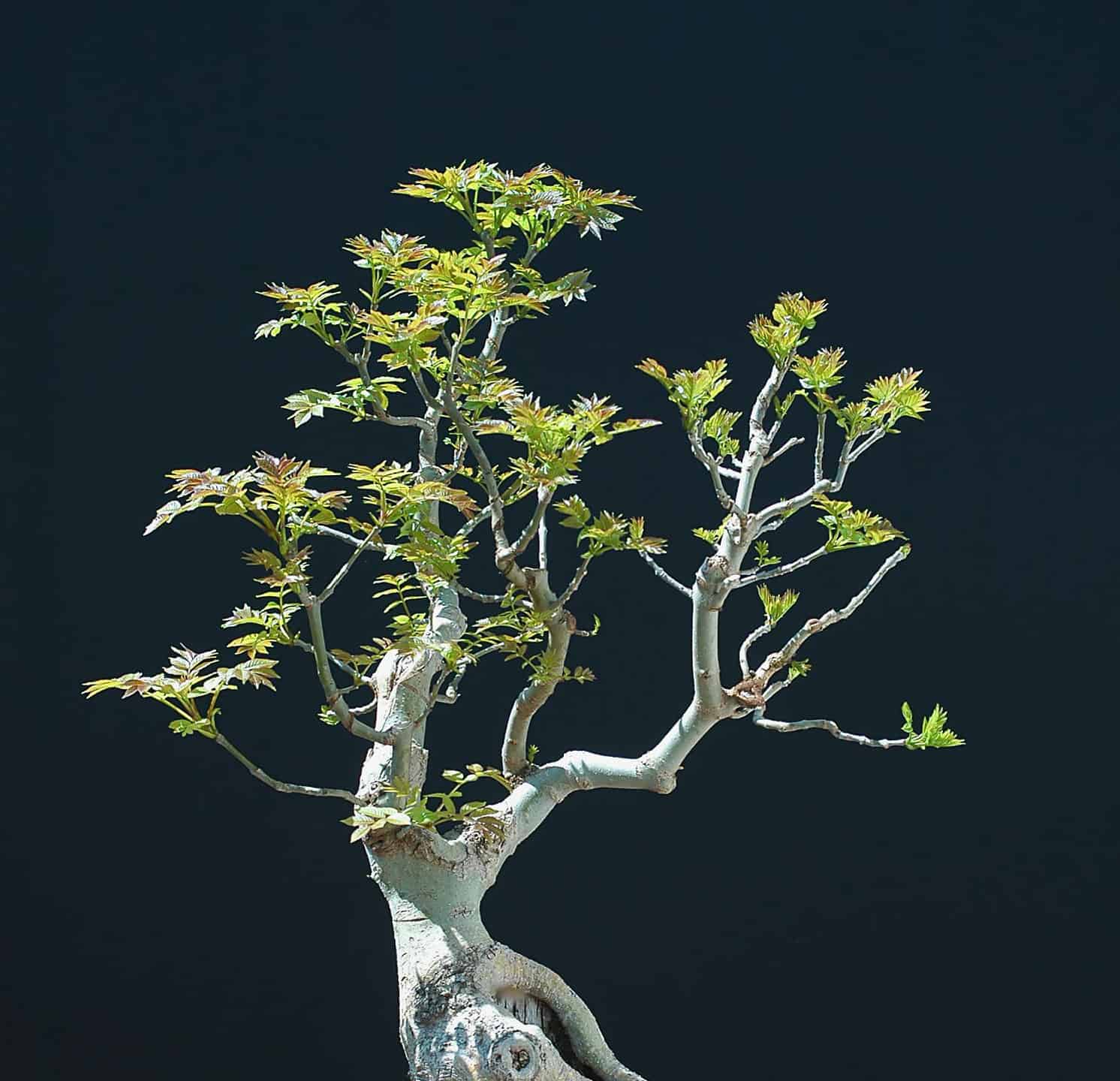
Olive trees are very versatile and can be grown as a bonsai, a houseplant, and outdoors.
©Walter Pall/Shutterstock.com
The olive tree’s small and linear dark green leaves are a perfect complement for its light-colored bark. Indoors, you can expect a height of up to 6 feet. Most indoor varieties are non-fruiting, but regular fruiting olive trees can reach around the same height. However, you might never get olives from an indoor tree if you can’t provide full sun for at least six hours of the day. If you’re not looking to produce olives, then any bright and sunny window will suit it well.
18. Tree Philodendron (Philodendron bipinnatifidum)
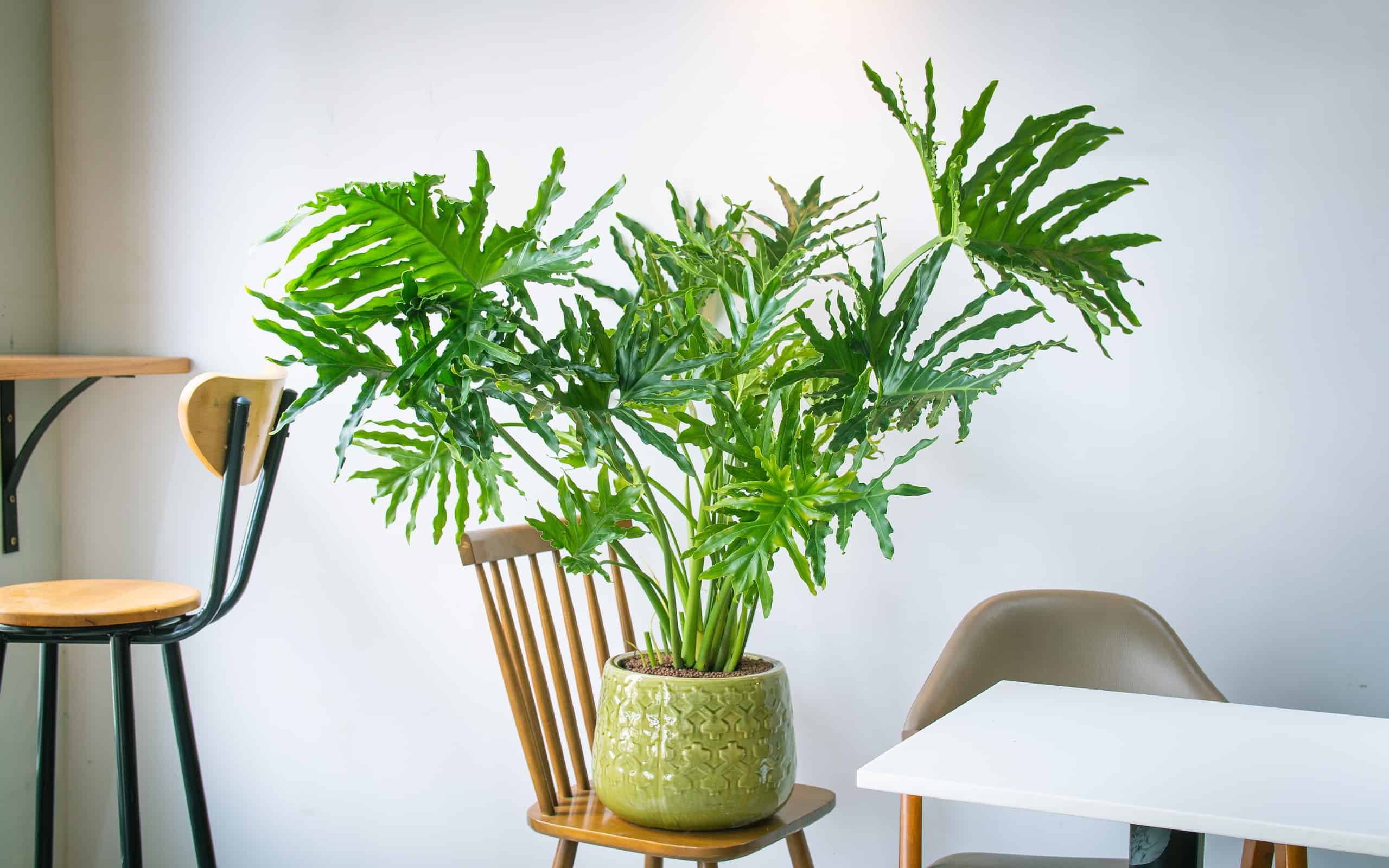
For a mature specimen, you might have to section off half the room to this plant!
©Mid Tran Designer/Shutterstock.com
Tree philodendrons can have massive leaves of up to 3 feet in length. Indoors, you can expect this non-climbing plant to get to be over 8 feet tall and just as wide. To limit its growth, you can prune it regularly or keep it in a small pot. Alternatively, you can split it into multiple pots. If you want it to go crazy, be sure you’re providing it with medium to bright indirect light. Humidity should be above 60% and watering should occur when the top 2-3 inches of soil is dry.
19. Umbrella Tree (Schefflera actinophylla)

Umbrella trees can be one solid green color or variegated with white or light green to yellow.
©M.photostock/ via Getty Images
This houseplant can grow to be 10 feet tall indoors if your ceilings allow for that height. They have a dense canopy of leathery leaves that hang pendulously from their stems. It’s a plant to be admired, and its ease of care and versatility makes it one of the most popular houseplants amongst beginners and old-timers alike.
20. Areca Palm (Chrysalidocarpus lutescens)

This palm is commonly
over 30 feet tall and 15 feet wide
in its natural outdoor habitat.
©Makabas/Shutterstock.com
The areca palm can easily grow up to 8 feet tall indoors when all of its needs are met. Provide bright but indirect light and protect this plant from drafts. Since it is native to tropical areas of Madagascar, it prefers partial shade and moist soil. The humidity should be at least above 50% to retain its hydrated and vivid green leaves.
21. Elephant Ear Alocasia (Alocasia macrorrhizos)
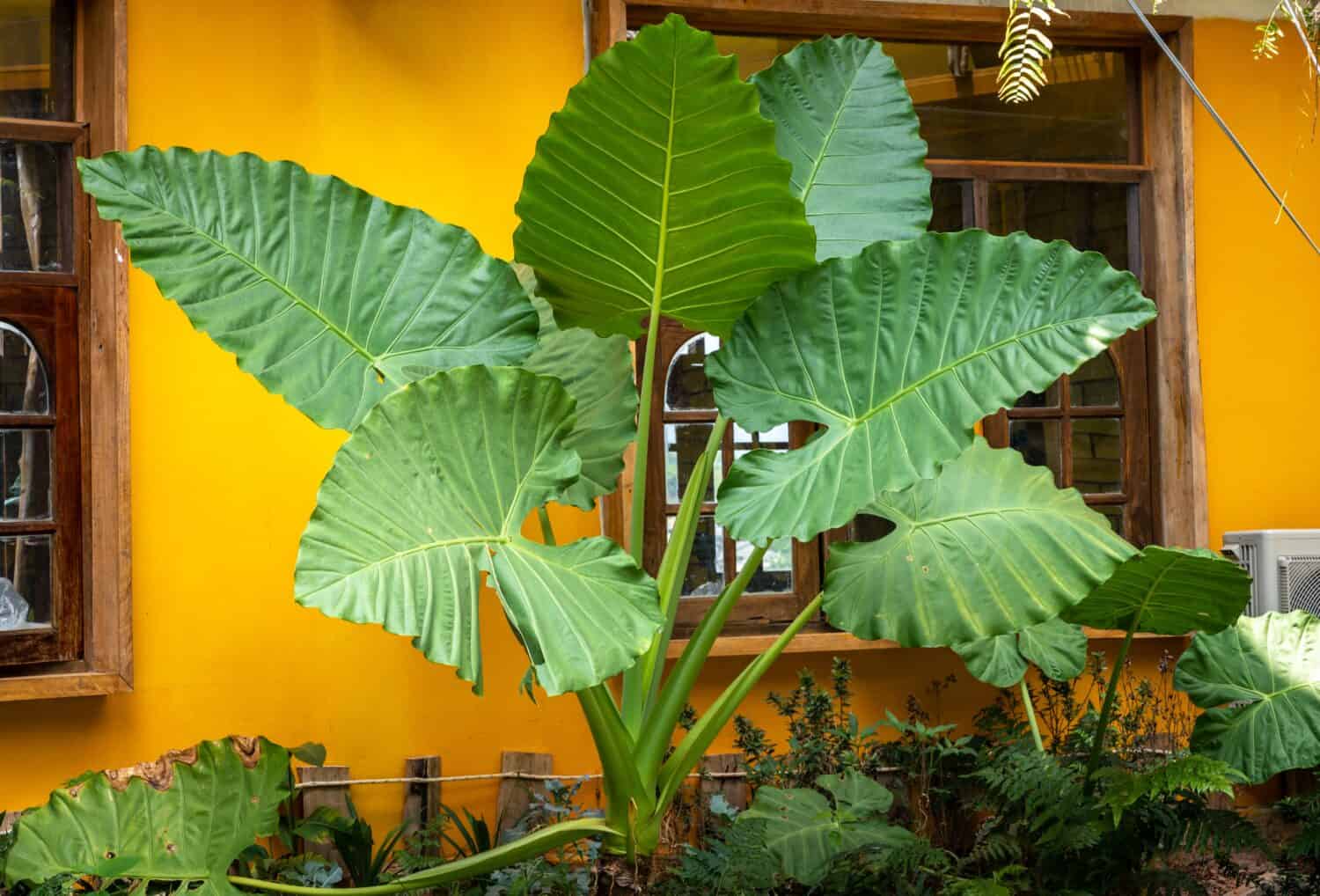
If you’re looking for a statement plant, the
elephant
alocasia should be a major consideration.
©Boyloso/Shutterstock.com
There are many different cultivars of this type of alocasia, with most getting between 3-5 feet tall. A signature of this plant is its large leaves, and elephant alocasia most certainly meets this requirement. With leaves growing to be 2 feet wide, they live up to their name. This moderately tall and wide-growing houseplant is easy to maintain with a constant temperature and high levels of humidity. Be sure it is getting bright, but indirect light.
22. Spineless Yucca (Yucca elephantipesis)

Yuccas and some species of draceanas can easily be mistaken for each other.
©Jokerbee12/ via Getty Images
This evergreen plant can grow up to 5 feet tall when grown as a houseplant. Its trunk is textured and will occasionally sprout new plants. They can eventually be separated and grow in their own pots. To best care for this plant, allow the soil to dry out almost entirely before watering deeply. Give it the brightest light you can, and only move it if you notice the leaves are starting to burn.
23. Pencil Cactus (Euphorbia tirucalli)
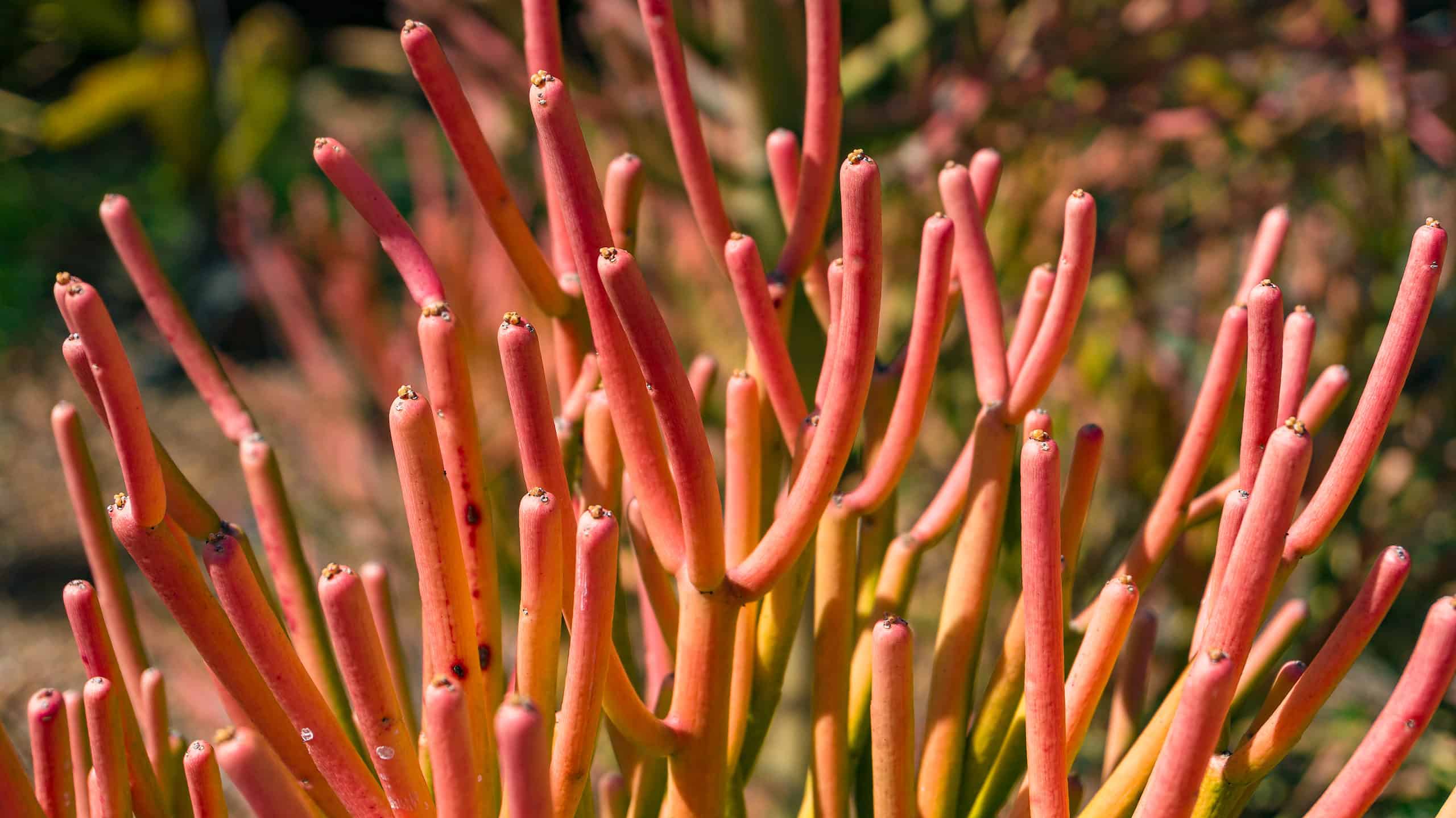
Pencil cacti are not a true species of cactus, and they lack spines.
©Olga Kashubin/Shutterstock.com
A pencil cactus can be just the weird-looking tall houseplant you’re looking for. They almost have a coral-like appearance in their many branching arms. You can look forward to this plant getting about 6 feet tall when kept indoors. Bright sun exposure can help bring out their colors as well as make sure they have robust, healthy growth.
24. Snake Plant (Dracaena trifasciata)

These plants reproduce from underground bulbs called rhizomes.
©Adam Yee/Shutterstock.com
Snake plants have a few different shades and patterns to their leaves. Their singular, sword-shaped leaf makes them a fun alternative to most other “leafier” looking plants. Additionally, snake plants are very easy to care for and can thrive in low light. They are also fairly drought tolerant thanks to their water-storing succulent leaves. Snake plants can reach 3 to 4 feet tall when kept as houseplants. In the wild, they can get over 6 feet tall.
25. Cast Iron Plant (Aspidistra elatior)
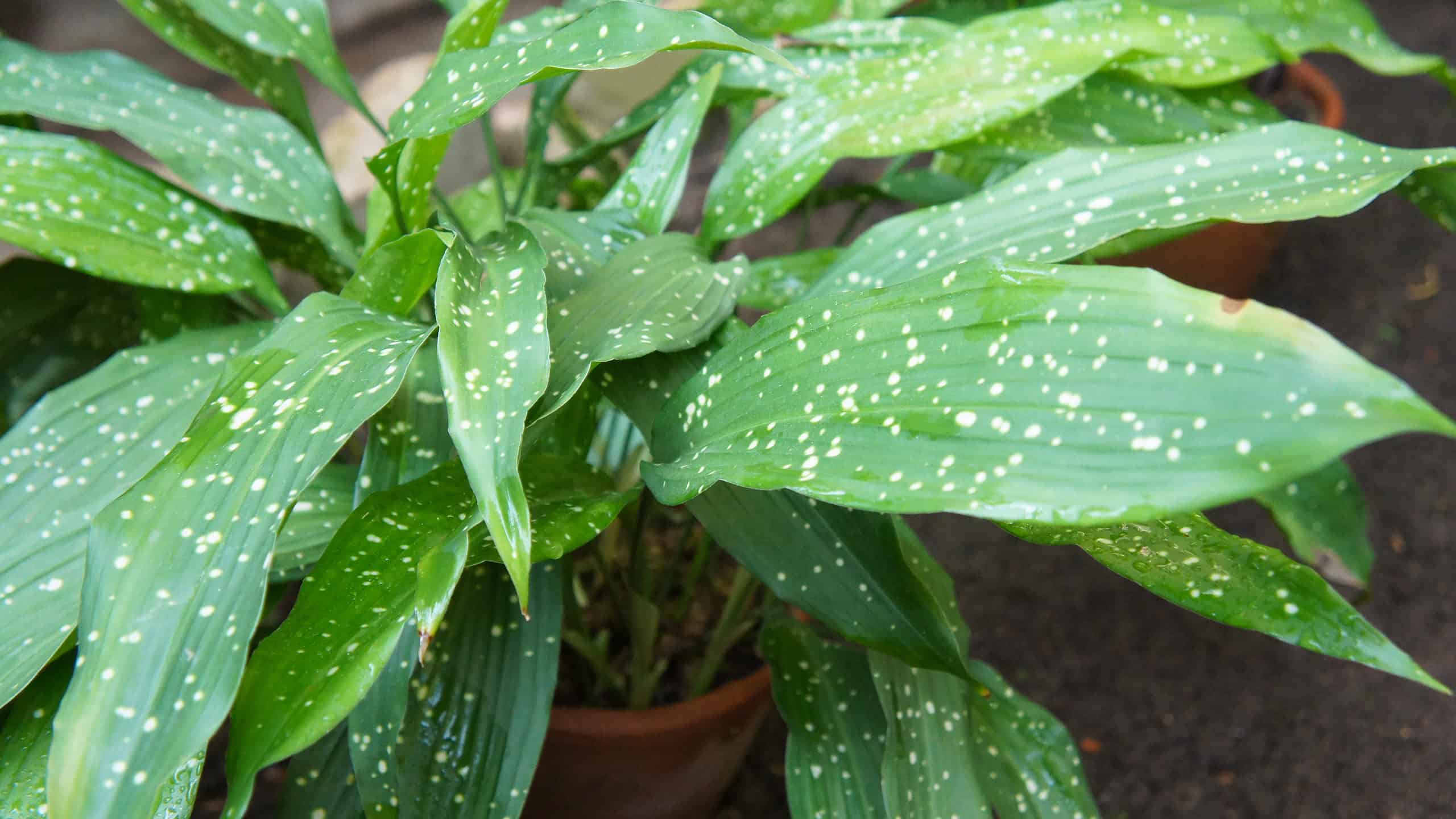
The leaves on a cast iron plant can be plain, spotted, or have some variegated stripes.
©mizy/Shutterstock.com
Cast iron plants are some of the hardiest plants a person can own. This unkillable houseplant is usually capping out at around 3 feet in height. It also can have a spread of 1-2 feet which makes this a compact yet stately plant. Since it also requires very little in the way of maintenance, it is a good starter plant for new plant parents.
26. Stingray Alocasia (Alocasia macrorrhiza ‘Stingray‘)

In addition to their oddly shaped leaves, the stems of this plant are striped.
©narin_nonthamand/ via Getty Images
Alocasias have a wide variety of leaf shapes to choose from. This one, aptly named after a stingray, features a wide, rounded leaf with a “stinger” shaped leaf tip. While it’s not a very dense-growing plant, it can reach up to 3 feet tall. It’s not the tallest plant on this list, but its interesting shape is sure to add some character to whatever room it lives.
27. Alocasia Portei (Alocasia portei)

The large leaves of alocasias are deeply lobed with very wavy margins.
©Firn/ via Getty Images
If you’re looking for a tall houseplant but you want something unique, here is the plant for you. Alocasia portei, also called “Malaysian Monster”, has large leaves with thin, ruffled-looking lobes. The overall height of this plant can reach around 4 feet in height, but its leaves can get to be over a foot in length. Its dramatic appearance definitely draws a lot of attention to the plant. To keep it looking as noteworthy as it should, keep humidity levels above 50% and allow the top few inches. of soil to dry before watering.
The photo featured at the top of this post is © ArtBackground/Shutterstock.com
Thank you for reading! Have some feedback for us? Contact the AZ Animals editorial team.







